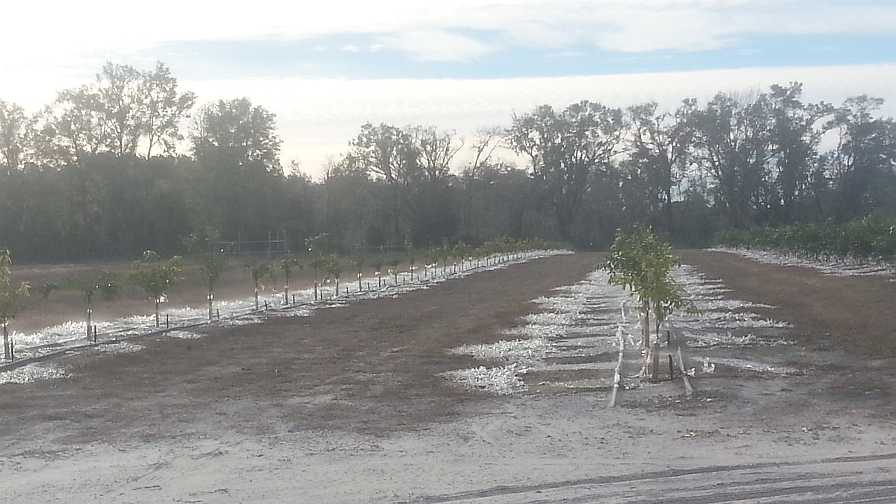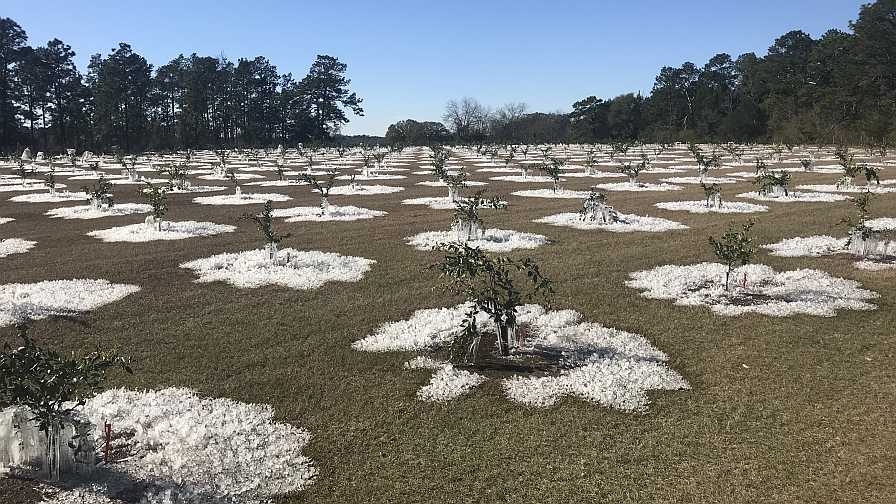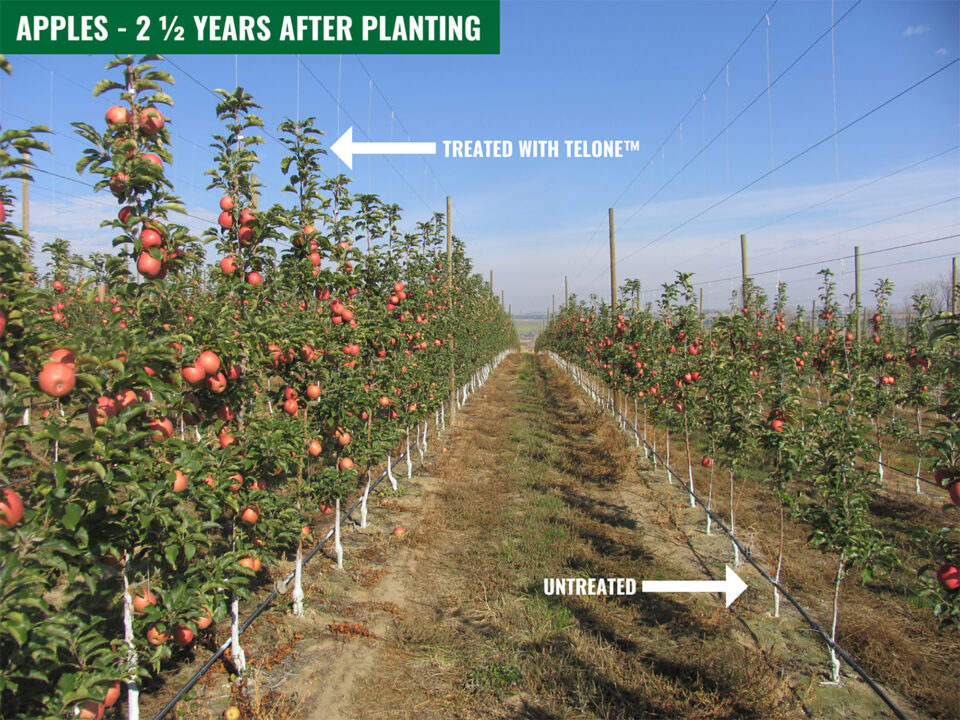Cold Weather Puts New Northern Citrus Plantings to the Test

Despite enduring temperatures not seen in some time, groves around Perry, FL, appeared to have come through in good shape thanks to diligent freeze protection practices.
Photo by Andy Jackson
The recent surge of interest in planting citrus in North Florida border counties and Southern Georgia and Alabama was put to the test this winter. While evaluation is still underway, these were significant weather events that served as a reminder, that though average temperatures in recent years have trended upward, extreme events can challenge the best freeze protection measures and help identify the truly cold-tolerant varieties. Let’s take a quick look at how things panned-out for our friends to the north:
North Florida
As previously reported, these areas have traditionally planted Satsuma varieties on trifoliate rootstocks. This combination has proven to be quite tolerant of extreme temperatures and the fruit has sold well in local markets. As the commitment of acreage to citrus has expanded, most of the production is still targeted toward Satsuma, but with interest in trying other varieties. Experimental plantings of UF/IFAS FAST TRACK selections, Navel oranges, ‘Sugar Belle,’ ‘Tango,’ ‘Gold Nugget,’ and ‘US Early Pride,’ as well as the University of Georgia ‘Pink Frost’ grapefruit, ‘Grand Frost’ lemon, and ‘Sweet Frost’ tangerine are in the ground. Interest is focused primarily, but not exclusively on early maturing varieties. Growers are banking on the protection afforded by reliable water sources and a mix of the right varieties.
Satsuma is a known entity in the northern counties; everything else is somewhat experimental. Some varieties can do quite well if you can get them through their second year, but the small trees can take a hit from the cold. Others may be more susceptible all the way through. It will take some time to see which varieties are suited for these areas and which ones produce the internal quality demanded by today’s market.
Clay Olson, Taylor County Extension, shared some information from Taylor and Madison counties. The first freeze event ran from Jan. 1 to Jan. 7, with temperatures ranging from 22°F to 27°F for extended periods of time.
The second event ran from January 17 to Jan. 20. The 17th and 18th presented temperatures in the high teens and low 20s, precisely the kind of temperatures that will test the system. Most of the trees in the UF/IFAS plantings had minimal fruit set due to a freeze event last March when temperatures dipped into the 20s. That March event knocked off the bloom and the trees did not bloom again. This year, freezing rain may have presented the greatest challenge, causing limb breakage on some of the young trees. Generally speaking, the freeze protection measures worked well, with minimal leaf burn and no significant damage to larger wood.
Andy Jackson in Perry FL, reported that the groves look pretty good. Historically, they see the last severe cold around St. Patrick’s Day. As of late January, despite some pretty cold days, the area was running under the historical averages for freezing weather. The lowest temperature was around 20°F. During the longest six-day freeze event, it was necessary to run the irrigation for three continuous days. The ‘US Early Pride’ trees fared pretty well, as did the Navels. The ‘Orlando’ tangelos look a bit rough, but with no substantial damage. As expected, the Satsumas did the best. The ‘Sugar Belle’ trees that were planted last spring were the hardest hit. ‘Sugar Belle’ is pretty durable with cold — once it reaches age two. Until then, it can suffer some damage. Any weaknesses in the irrigation system were certainly exposed, but Jackson believed they got out without any significant damage.

During one recent stretch of freezing weather, Georgia citrus growers ran microjet irrigation for six days straight to help stave off cold damage.
Photo by Lindy Savelle
Georgia
Lindy Savelle, President of the Georgia Citrus Association, provided some helpful feedback on their situation:
• ‘Frost Owari’ and ‘Brown Select’ Satsumas represent 75% of the recent Georgia plantings. Small quantities of Navel, ‘Kishu,’ UGA tangerines, ‘Tango,’ and ‘Sugar Belle’ are being tried.
• At the end of 2017, approximately 42,000 trees were in the ground in Georgia, with 47% of those being planted in 2017. Only about 14,000 trees are three years old.
• The most popular rootstocks are Rubidoux and Flying Dragon, with a few Rich Trifoliate and Carrizo scattered in.
• The tangerines and Satsumas did the best with the cold temperatures, though Navels, ‘Kishu,’ and grapefruit fared pretty well. The lemons are showing some burn-back, and the limes didn’t do so well. They have identified a variant of Persian lime that they believe to be more cold tolerant — but there are not many trees propagated at this time.
• The damage that has occurred includes some burn-back on the limbs, but just a few inches. The final flushes from last year were lost. Trees were not fully dormant when the coldest whether hit. There were some scattered reports of splitting bark. Quite a few of the trees have dropped their leaves — and these are expected to recover. So far, limes are the only ones with significant damage.
• Overall, growers are encouraged to plant more — as they are pleased with the performance of the young trees through these first two cold events. They are waiting to see how the trees recover. If the trees bounce back, expect to see more planting moving forward.
• Microjet irrigation is providing effective protection from the cold. Growers are running the microjets when temperatures are expected to drop below 28°F. During one cold snap, the jets ran for six days straight — as the temperatures didn’t get high enough to turn off the water.
All indications are citrus production in the North Florida and South Georgia and Alabama counties is just beginning. As acreage expands, infrastructure will follow. Growers from these areas are becoming familiar faces at workshops, field days, and industry meetings down south.
Likewise, growers and packers in the main production areas are attending events up north to keep apprised of the latest developments. The industry is quickly changing and the family appears to be expanding.










